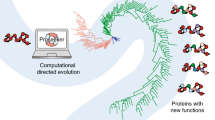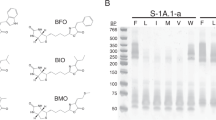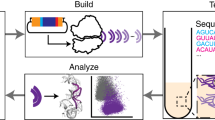Abstract
Determining how large RNA molecules stabilize their tertiary structures is critical for understanding how they perform their biological functions. Here we use in vitro selection to identify active variants of the Tetrahymena ribozyme with increased stability. The mutant pool converged to a single family that shared nine mutations; an RNArepresenting the consensus sequence was structurally more stable by 10.5 °C and catalytically active at elevated temperatures. Remarkably, of the nine altered sites, most are already known to be involved in tertiary interactions, and the stabilizing mutations primarily improve the packing interactions in the molecular interior. The wild type ribozyme and the selected mutants provide pairs of mesophilic and thermophilic homologs for studying the origin of their thermal stability.
This is a preview of subscription content, access via your institution
Access options
Subscribe to this journal
Receive 12 print issues and online access
$189.00 per year
only $15.75 per issue
Buy this article
- Purchase on Springer Link
- Instant access to full article PDF
Prices may be subject to local taxes which are calculated during checkout






Similar content being viewed by others
References
Vieille, C. & Zeikus, G.J. Hyperthermophilic enzymes: sources, uses, and molecular mechanisms for thermostability. Microbiol. Mol. Biol. Rev. 65, 1–43 (2001).
Petsko, G.A. Structural basis of thermostability in hyperthermophilic proteins, or “there's more than one way to skin a cat”. Methods Enzymol. 334, 469–478 (2001).
Jaenicke, R. & Bohm, G. Thermostability of proteins from Thermotoga maritima. Methods Enzymol. 334, 438–469 (2001).
Doudna, J.A. & Cech, T.R. The chemical repertoire of natural ribozymes. Nature 418, 222–228 (2002).
Burkard, M.E., Turner, D.H. & Tinoco, I. Jr in RNA World (eds Gesteland, R., Cech, T.R. & Atkins, J.) 233–264 (Cold Spring Harbor Laboratory Press, Cold Spring Harbor; 1999).
Conn, G.L. & Draper, D.E. RNA structure. Curr. Opin. Struct. Biol. 8, 278–285 (1998).
Watanabe, K., Oshima, T., Iijima, K., Yamaizumi, Z. & Nishimura, S. Purification and thermal stability of several amino acid-specific tRNAs from an extreme thermophile, Thermus thermophilus HB8. J. Biochem. 87, 1–13 (1980).
Kowalak, J.A., Dalluge, J.J., McCloskey, J.A. & Stetter, K.O. The role of posttranscriptional modification in stabilization of transfer RNA from hyperthermophiles. Biochemistry 33, 7869–7876 (1994).
Galtier, N. & Lobry, J.R. Relationships between genomic G+C content, RNA secondary structures, and optimal growth temperature in prokaryotes. J. Mol. Evol. 44, 632–636 (1997).
Brown, J.W., Haas, E.S. & Pace, N.R. Characterization of ribonuclease P RNAs from thermophilic bacteria. Nucleic Acids Res. 21, 671–679 (1993).
Fang, X.W. et al. The thermodynamic origin of the stability of a thermophilic ribozyme. Proc. Natl. Acad. Sci. USA 98, 4355–4360 (2001).
Reinhold-Hurek, B. & Shub, D.A. Self-splicing introns in tRNA genes of widely divergent bacteria. Nature 357, 173–176 (1992).
Tanner, M. & Cech, T. Activity and thermostability of the small self-splicing group I intron in the pre-tRNA(Ile) of the purple bacterium Azoarcus. RNA 2, 74–83 (1996).
Juneau, K. & Cech, T.R. In vitro selection of RNAs with increased tertiary structure stability. RNA 5, 1119–1129 (1999).
Juneau, K., Podell, E., Harrington, D.J. & Cech, T.R. Structural basis of the enhanced stability of a mutant ribozyme domain and a detailed view of RNA–solvent interactions. Structure 9, 221–231 (2001).
Cate, J.H. et al. Crystal structure of a group I ribozyme domain: principles of RNA packing. Science 273, 1678–1685 (1996).
Cech, T.R. The chemistry of self-splicing RNA and RNA enzymes. Science 236, 1532–1539 (1987).
Cech, T.R. Self-splicing of group I introns. Annu. Rev. Biochem. 59, 543–568 (1990).
Golden, B.L., Gooding, A.R., Podell, E.R. & Cech, T.R. A preorganized active site in the crystal structure of the Tetrahymena ribozyme. Science 282, 259–264 (1998).
Szewczak, A.A., Podell, E.R., Bevilacqua, P.C. & Cech, T.R. Thermodynamic stability of the P4-P6 domain RNA tertiary structure measured by temperature gradient gel electrophoresis. Biochemistry 37, 11162–11170 (1998).
Fromant, M., Blanquet, S. & Plateau, P. Direct random mutagenesis of gene-sized DNA fragments using polymerase chain reaction. Anal. Biochem. 224, 347–353 (1995).
Beaudry, A.A. & Joyce, G.F. Directed evolution of an RNA enzyme. Science 257, 635–641 (1992).
Laing, L.G., Gluick, T.C. & Draper, D.E. Stabilization of RNA structure by Mg ions. Specific and non-specific effects. J. Mol. Biol. 237, 577–587 (1994).
Banerjee, A.R., Jaeger, J.A. & Turner, D.H. Thermal unfolding of a group I ribozyme: the low-temperature transition is primarily disruption of tertiary structure. Biochemistry 32, 153–163 (1993).
Cannone, J.J. et al. The Comparative RNA Web (CRW) Site: an online database of comparative sequence and structure information for ribosomal, intron, and other RNAs. BMC Bioinformatics 3, 2 (2002).
Heuer, T.S., Chandry, P.S., Belfort, M., Celander, D.W. & Cech, T.R. Folding of group I introns from bacteriophage T4 involves internalization of the catalytic core. Proc. Natl. Acad. Sci. USA 88, 11105–11109 (1991).
Couture, S. et al. Mutational analysis of conserved nucleotides in a self-splicing group I intron. J. Mol. Biol. 215, 345–358 (1990).
Strobel, S.A. & Shetty, K. Defining the chemical groups essential for Tetrahymena group I intron function by nucleotide analog interference mapping. Proc. Natl. Acad. Sci. USA 94, 2903–2908 (1997).
Ortoleva-Donnelly, L., Szewczak, A.A., Gutell, R.R. & Strobel, S.A. The chemical basis of adenosine conservation throughout the Tetrahymena ribozyme. RNA 4, 498–519 (1998).
Michel, F. & Westhof, E. Modelling of the three-dimensional architecture of group I catalytic introns based on comparative sequence analysis. J. Mol. Biol. 216, 585–610 (1990).
Lehnert, V., Jaeger, L., Michel, F. & Westhof, E. New loop-loop tertiary interactions in self-splicing introns of subgroup IC and ID: a complete 3D model of the Tetrahymena thermophila ribozyme. Chem. Biol. 3, 993–1009 (1996).
Michel, F., Ellington, A.D., Couture, S. & Szostak, J.W. Phylogenetic and genetic evidence for base-triples in the catalytic domain of group I introns. Nature 347, 578–580 (1990).
Szewczak, A.A. et al. An important base triple anchors the substrate helix recognition surface within the Tetrahymena ribozyme active site. Proc. Natl. Acad. Sci. USA 96, 11183–11188 (1999).
Murphy, F.L. & Cech, T.R. An independently folding domain of RNA tertiary structure within the Tetrahymena ribozyme. Biochemistry 32, 5291–5300 (1993).
Doherty, E.A. & Doudna, J.A. The P4-P6 domain directs higher order folding of the Tetrahymena ribozyme core. Biochemistry 36, 3159–3169 (1997).
Zarrinkar, P.P. & Williamson, J.R. Kinetic intermediates in RNA folding. Science 265, 918–924 (1994).
Sclavi, B., Sullivan, M., Chance, M.R., Brenowitz, M. & Woodson, S.A. RNA folding at millisecond intervals by synchrotron hydroxyl radical footprinting. Science 279, 1940–1943 (1998).
Cunningham, L., Kittikamron, K. & Lu, Y. Preparative-scale purification of RNA using an efficient method which combines gel electrophoresis and column chromatography. Nucleic Acids Res. 24, 3647–3648 (1996).
Guo, F. & Cech, T.R. In vivo selection of better self-splicing introns in Escherichia coli: the role of the P1 extension helix of the Tetrahymena intron. RNA 8, 647–658 (2002).
Savitzky, A. & Golay, M.J.E. Smoothing and differentiation of data by simplified least squares procedures. Anal. Chem. 36, 1627–1639 (1964).
Mei, R. & Herschlag, D. Mechanistic investigations of a ribozyme derived from the Tetrahymena group I intron: insights into catalysis and the second step of self-splicing. Biochemistry 35, 5796–5809 (1996).
Acknowledgements
We are grateful to H. Brummel and K. Kossen for help with the UV melting experiments. We thank A. Gooding for providing T7 RNA polymerase and E. Podell and K. Goodrich for oligonucleotide synthesis. We also thank A. Zaug, A. Berglund, E. Podell, P. Baumann and G. Joyce for insightful discussions.
Author information
Authors and Affiliations
Corresponding author
Ethics declarations
Competing interests
The authors declare no competing financial interests.
Rights and permissions
About this article
Cite this article
Guo, F., Cech, T. Evolution of Tetrahymena ribozyme mutants with increased structural stability. Nat Struct Mol Biol 9, 855–861 (2002). https://doi.org/10.1038/nsb850
Received:
Accepted:
Published:
Issue Date:
DOI: https://doi.org/10.1038/nsb850



